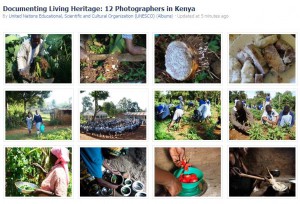 There’s a great set of pictures of Kenyan traditional crops and food preparation on UNESCO’s Facebook page, in their Documenting Living Heritage series. This is part of an exhibition currently on at UNESCO’s HQ in Paris to raise awareness of the 2003 Convention for the Safeguarding of Intangible Cultural Heritage. I doubt there’s a photograph of the Gene Bank of Kenya, but that surely contributes to that goal too.
There’s a great set of pictures of Kenyan traditional crops and food preparation on UNESCO’s Facebook page, in their Documenting Living Heritage series. This is part of an exhibition currently on at UNESCO’s HQ in Paris to raise awareness of the 2003 Convention for the Safeguarding of Intangible Cultural Heritage. I doubt there’s a photograph of the Gene Bank of Kenya, but that surely contributes to that goal too.
Nibbles: CWR, ICRISAT, Fruits, Maize, Symbionts, Tissue culture, Vegetables, Med diet
- ICARDA saves the world.
- No, ICRISAT saves the world.
- You’re both wrong, it’s CIAT.
- No, wait, maybe it’s CIMMYT. Oh I give up.
- Actually it’s fungi.
- Or maybe tissue culture?
- Surely it can’t be five unknown vegetables?
- Could it be that it’s the Mediterranean diet? And that UNESCO will screw it up for all of us?
Nibbles: Hunger foods, Pollinators, Sacred Seeds, Neglected species, Grasses, Yields, Hawaiian History
- Mining Mungo Park for info about famine foods. Bamboo seeds and, perhaps, baobab pods.
- The big prerequisite for EU funding is a good acronym. STEP — status and trends of European pollinators — gets the go ahead.
- Sacred Seeds project at Missouri Botanical Garden announces new partners in India.
- New Bioversity project to extend importance of work on neglected species in India, Nepal and Bolivia.
- How to manage diverse grasses.
- More on climate change and maize yields. “[I]f anything heat tolerance is declining.”
- Ancient agriculture in Hawaii.
Brainfood: Millet biscuits, Wheat micronutrients, Diversification and C footprint, Agroforestry, Epazote, Grape history, Belgian farmers, Millet phenology, Species migration, Barley domestication, Sheep genetics
- Quality characteristics of biscuits prepared from finger millet seed coat based composite flour. They’re nutritious. Crocodile Dundee on the tastiness of the iguana may, however, apply.
- Minerals and trace elements in a collection of wheat landraces from the Canary Islands. There are differences, but environment and agronomic practices could affect them.
- Lowering carbon footprint of durum wheat by diversifying cropping systems. Yes, by 7-34%, depending on how the diversification was done.
- Effect of shading by baobab (Adansonia digitata) and néré (Parkia biglobosa) on yields of millet (Pennisetum glaucum) and taro (Colocasia esculenta) in parkland systems in Burkina Faso, West Africa. Taro is a shade lover; grow it under néré, and vice versa.
- Ethnobotanical, morphological, phytochemical and molecular evidence for the incipient domestication of Epazote (Chenopodium ambrosioides L.: Chenopodiaceae) in a semi-arid region of Mexico. Good to know; I love epazote.
- Grape varieties (Vitis vinifera L.) from the Balearic Islands: genetic characterization and relationship with Iberian Peninsula and Mediterranean Basin. See the grand sweep of European history unfold.
- Microsatellite characterization of grapevine (Vitis vinifera L.) genetic diversity in Asturias (Northern Spain). No evidence of communication with the previous group.
- Plant economy of the first farmers of central Belgium (Linearbandkeramik, 5200–5000 b.c.). They were dope fiends.
- Selection for earlier flowering crop associated with climatic variations in the Sahel. Compared to 1976 millet samples, samples collected in 2003 had shorter lifecycle (due to an early flowering allele at the PHYC locus increasing in frequency), and a reduction in plant and spike size. So you don’t need new varieties, the old ones will adapt to climate change. Oh, and BTW, there’s been no genetic erosion.
- Do species’ traits predict recent shifts at expanding range edges? No.
- The domestication syndrome genes responsible for the major changes in plant form in the Triticeae crops. Failure to disarticulate and 6-rows in barley, in detail. Part of a Special Issue on Barley.
- The genetics of colour in fat-tailed sheep: a review. I didn’t know karakul had fat tails.
Diverse lawns are smarter lawns
 There’s been a lot of talk lately about the demise of the Great American Lawn. Or at least its metamorphosis into something a little more sustainable. Even the White House lawn is not immune to re-development. But a recent post on the Native Plants mailing list of the Plant Conservation Alliance points to what may be the beginnings of a backlash. Here’s what Mark Simmons had to say in response to an article in the Star Tribune entitled Goodbye to Grass (Mark’s comments are reproduced here with his permission):
There’s been a lot of talk lately about the demise of the Great American Lawn. Or at least its metamorphosis into something a little more sustainable. Even the White House lawn is not immune to re-development. But a recent post on the Native Plants mailing list of the Plant Conservation Alliance points to what may be the beginnings of a backlash. Here’s what Mark Simmons had to say in response to an article in the Star Tribune entitled Goodbye to Grass (Mark’s comments are reproduced here with his permission):
I really like my lawn – my low maintenance, species-rich, drought-adapted native lawn.
While I agree that lawns can be replaced with alternative vegetation, I think that the lawn is entitled to a place in the American landscape and we should be careful of following the current fashion of demonizing turf. It’s not the lawn that’s the problem is how lawns are manufactured. We take a usually single non-native species that’s been bred to rely on a life-support system of water, fertilizer, pesticides herbicides, and a crazy mowing regimen. If you look at native short grasslands around the world its clear that, in contrast, they are low nutrient, species-rich, systems which are at ecological quasi-equilibrium usually maintained by grazing and or fire. Here at the Lady Bird Johnson Wildflower Center we adopted an ecological approach to turf by testing different mixes of native turf grasses and against a commonly-used non-native turf lawn species (bermudagrass) and measured performance. The multispecies native mix needs less mowing, had less weeds and was a denser, finer (better looking) turf. The results were just published in the journal Ecological Engineering. Sure it can go drought-dormant and brown in summer if it’s not watered. But if that may be an acceptable alternative to no lawn at all.
My young children can’t play baseball in gravel and agaves. And I want to sink a beer on a Saturday evening bare foot in soft, cool turf. Let’s keep doing lawns, just do them smart.